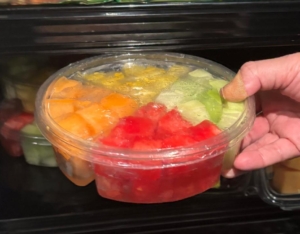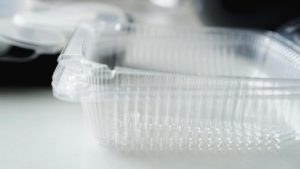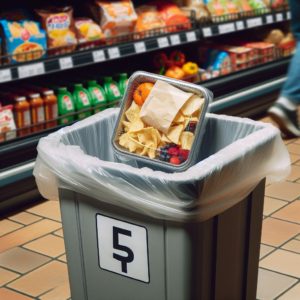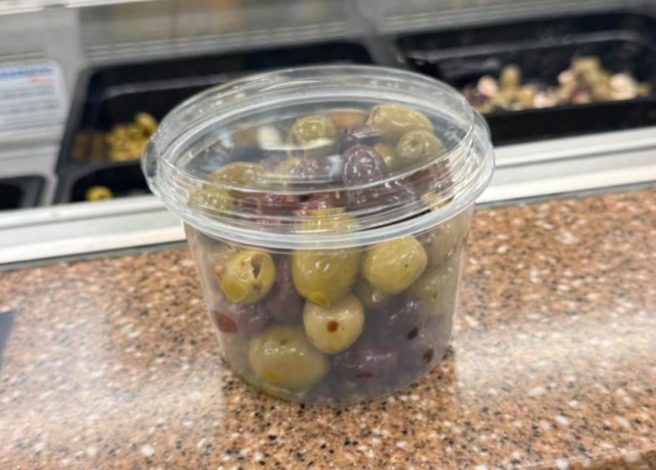A single leaking container in a deli case can spoil an entire display, turning what should be an appealing presentation into lost revenue. Common grocery store packaging problems can extend beyond simple annoyances — they directly impact food safety, waste management, and the bottom line. From prepared foods to produce, the right packaging can make the difference between products that sell and those that stay on the shelf.
The idea of anything potentially harming your business can be scary. Inline Plastics has been working with grocery stores for over fifty years. We want to share what we have learned about the problems these stores face daily.
This article will identify key issues you may see in your store and discuss how they can affect the bottom line. Don’t worry, we won’t leave it there. We will also provide practical solutions so you can focus on getting your products into the hands of the smiling customers you see every day.
The Eight Problems Grocery Retailers Are Having
Let’s dive deeper into the problems you might be seeing in your store.
The Packages Are Leaking
 Imagine picking up a container of fruit at the store. You don’t want to find juice dripping out, making the packaging sticky and perceived as dirty, or fruit that looks bad because of poor packaging. One of the most significant problems is container leakage, particularly with wet food items. For example, juicy watermelon can seep through lower-quality containers. These problems compromise food safety, reduce shelf life, and result in potential food waste and customer dissatisfaction.
Imagine picking up a container of fruit at the store. You don’t want to find juice dripping out, making the packaging sticky and perceived as dirty, or fruit that looks bad because of poor packaging. One of the most significant problems is container leakage, particularly with wet food items. For example, juicy watermelon can seep through lower-quality containers. These problems compromise food safety, reduce shelf life, and result in potential food waste and customer dissatisfaction.
Solution: Opt for high-quality, leak-resistant containers for products with liquid components. These packages are specifically designed to handle wet food applications and will save you time, money, and a headache.
The Package Ruins the Contents Inside
Stores often end up with packages that don’t work well for their needs. Sometimes lids don’t fit their containers properly, or stores can’t find the right size package for their food portions. Other times, packages don’t keep food fresh or won’t stack neatly on shelves.
When packages don’t work right, customers worry about getting their food home safely. If lids pop off and food spills everywhere before a customer even makes it home, they might stop trusting the store and shop elsewhere.
Also, note the product’s application. Are you using the wrong packaging for hot foods? Are heat displays leading to warped packages? You don’t want a customer to bring home a container that’s transformed into a plastic origami swan.
Solution: Get samples of packaging you’re considering and test them with the application. Before you place an order or put your products on display:
- Test for stackability to ensure the packaging can withstand the weight of products piled on top of it.
- Run a ship test to verify the container can withstand movement and shipping, particularly if being sold or transported over high altitudes.
- Test for shelf life to see how long the product can last to prevent waste.
- Look for visual appeal to help bolster sales.
- If you have wet products, test for leak resistance.
- If your product is packaged hot, meant to be heated, or displayed in a hot display, make sure the packaging is designed for hot food applications, like polypropylene, foil, or foam.
- Consider using one-piece clamshell packages to ensure lids will always fit to bases.
Too Much Packaging Becoming a Logistical Nightmare
Grocery stores may deal with too many different types of packages. It can get confusing when trying to keep track of them all. Sometimes stores run out of lids while still having plenty of bases, or the other way around. There’s also the problem of where to keep all these different containers. It gets even trickier when various parts of the store, like the deli or bakery, need other types of packaging but want everything to look the same. 
Solution: You can adjust your needs for seasonality when items are in high demand and when you’re having special sales. This can help you stay organized and ahead of the game without having too little packaging or so much that it takes up all the storage space like an elephant in a Smart Car.
If You Buy for Price, You Buy Twice
Stores often try to save money by buying cheaper packages, which can cause bigger problems later. Cheap packages might not keep food fresh for long, so more food gets thrown away. When food looks bad in its package, customers don’t want to buy it. This means the store loses money in the long run.
Think about it this way: if consumers can’t see the contents, the packages don’t stack neatly, or bulge out on the sides, they make food look unappetizing. Remember, consumers buy with their eyes first, so if the food looks poor, it doesn’t sell well. Even if a store saves money by buying cheaper packages, it will lose money when customers don’t buy its products.
Another aspect to consider is the look and feel of the package. When a customer picks up a container and the perceived value feels cheap, they may think the contents of the package are cheap as well.
It’s Hard to See the Product
 When customers can’t see clearly through the packaging, they’re less likely to buy the product. Poor-quality plastic can look cloudy or have a colored tint, especially when it contains recycled materials. Cheaper packages often have other problems: lids that aren’t shaped correctly or contain tiny air bubbles trapped in the plastic, which might be seen as something in the food. These issues make it harder for shoppers to see what they’re buying.
When customers can’t see clearly through the packaging, they’re less likely to buy the product. Poor-quality plastic can look cloudy or have a colored tint, especially when it contains recycled materials. Cheaper packages often have other problems: lids that aren’t shaped correctly or contain tiny air bubbles trapped in the plastic, which might be seen as something in the food. These issues make it harder for shoppers to see what they’re buying.
Solution: Look for quality, design, and functionality of the package to give your products the best presentation and the best shelf life possible
Departments Are Not on the Same Page
Different departments within grocery stores have varying packaging needs. This creates inconsistent packaging across departments and difficulty maintaining visual uniformity. The situation leads to storage and inventory management challenges, increased ordering and stock management complexity, and training issues for staff across different departments. You must all be on the same page so you’re not over-ordering or purchasing packaging that doesn’t meet everyone’s required needs.
Solution: Consider having alignment meetings with department heads for their expected packaging needs throughout the year. These should influence your forecasting needs and should be flexible. Work with the manufacturer or distributor to advise on the ability to potentially consolidate the number of SKUs your store is using. One container in deli might work well with bakery.
Sustainability and Consumer Perception
Today’s grocery stores need to think about what works well and what’s good for the environment. Customers want packaging that won’t harm the planet, but they need clarification about which containers can be reused and which should be disposed of. Stores have to find packages that aren’t bad for the environment but still keep food fresh and safe. This isn’t easy. The packages must follow food safety rules and please customers.
Solution: Look for packaging with messages like “Please Recycle” to encourage the consumer to take the appropriate action with the container after use. Stay informed about market and sustainability trends with green guides provided by the FDA. Another great resource for staying current is the Sustainable Packaging Coalition (SPC) website.
Your Product Gets Tossed
We’re sure you know, but for anyone who doesn’t, “shrink” or “shrinkage” refers to the loss of inventory from when products are purchased from suppliers until their final sale. Think of it simply as products that don’t sell and have to be thrown away. 
Inadequate protection leads to spoilage, while improper sealing may reduce shelf life. Poor visibility affects sales velocity, and damage during handling and storage increases waste. Additionally, customers often reject visually unappealing packages, further contributing to shrinkage.
Solution: Make sure you’re investing in high-quality packaging from the onset (are you seeing a trend in these solutions?). Smart packaging choices today protect your profits tomorrow.
How Retailers Can Navigate These Challenges
Successful stores are solving these packaging problems by making changes across their business. They’re using the same high-quality packages in different departments and choosing containers that make their food look better. When stores invest in quality packaging, food stays fresher longer and is thrown away less. They also make sure their displays look consistent and work with packaging companies that offer quality products and good support, not just low prices.
The most successful stores don’t treat packaging like a commodity, something to buy at the lowest price. Instead, they see it as an investment that helps sell their products and keeps them fresh longer.
It’s wise to consider the immediate cost of packaging and how it will help the business over time.
Putting A Lid On Plastic Food Packaging Problems
 Choosing the right packaging is about more than fixing problems; it’s about helping your business grow. If you only focus on buying the cheapest packages, you’ll keep having problems and making less money over time. You also run the risk of damaging your brand if your packages are failing your product and your consumers. Spending more on better packaging helps in two ways: it ensures that your food gets to customers safely and shows them you care about quality. When customers trust your store, they keep coming back.
Choosing the right packaging is about more than fixing problems; it’s about helping your business grow. If you only focus on buying the cheapest packages, you’ll keep having problems and making less money over time. You also run the risk of damaging your brand if your packages are failing your product and your consumers. Spending more on better packaging helps in two ways: it ensures that your food gets to customers safely and shows them you care about quality. When customers trust your store, they keep coming back.
Your success matters — even if that means pointing you in a different direction. Let’s talk through your options. Inline Plastics is here to help.


